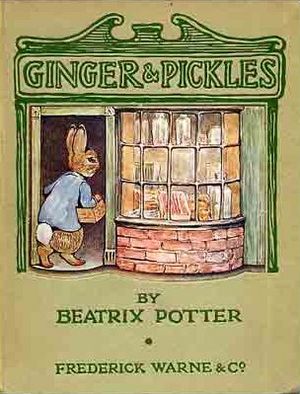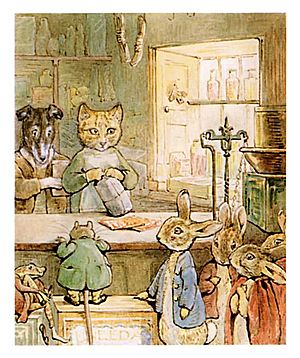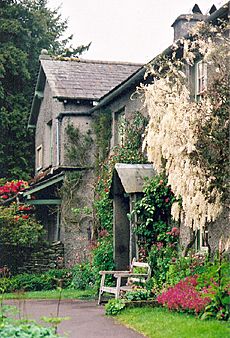The Tale of Ginger and Pickles facts for kids

First edition cover
|
|
| Author | Beatrix Potter |
|---|---|
| Illustrator | Beatrix Potter |
| Country | England |
| Language | English |
| Genre | Children's literature |
| Publisher | Frederick Warne & Co. |
|
Publication date
|
1909 |
| Media type | Print (hardcover) |
| Preceded by | The Tale of the Flopsy Bunnies |
| Followed by | The Tale of Mrs. Tittlemouse |
The Tale of Ginger and Pickles (originally, Ginger and Pickles) is a children's book written and illustrated by Beatrix Potter, and first published by Frederick Warne & Co. in 1909. The book tells of two shopkeepers who extend unlimited credit to their customers and, as a result, are forced to go out of business. It was originally published in a large format which permitted Potter the opportunity to lavish great detail on the illustrations and also allowed her to include black-and-white vignettes. Potter filled the tale with characters from her previous books. The book was eventually republished in the standard small format of the Peter Rabbit series and was adapted to drama in 1931.
Contents
Background
Helen Beatrix Potter was born to wealth and privilege on 28 July 1866 in London to barrister Rupert Potter and his wife Helen (Leech) Potter. Raised by a series of governesses, Beatrix filled her hours with reading, painting, drawing, and tending a schoolroom menagerie of small mammals, birds, reptiles, and amphibians. Summer holidays in Scotland or the Lake District and long visits to her grandparents' Camfield Place home in Hertfordshire cultivated her love for and observation of the natural world. As a young woman, she was discouraged from seeking higher education, and groomed instead to be a permanent resident and housekeeper in her parents' London home.
While summering with family in Perthshire in 1893, the 27-year-old Potter sent a story and picture letter about a disobedient young rabbit to the son of her former governess Annie Carter Moore, and continued to send similar letters to the boy and his siblings over the following years. Mrs. Moore recognized the literary value of the letters and urged her former charge to publish them. Potter developed the 1893 letter into The Tale of Peter Rabbit, and worked up a dummy book based on the small book format and style of Helen Bannerman's bestselling Little Black Sambo (1899) with its pages of simple texts opposite appropriate pictures.
The late Victorian and early Edwardian children's book market was flooded by inexpensive small format books with profusions of illustrations made possible by technological advances in colour reproduction. The publishing firm of Frederick Warne & Co. wanted to compete in this lucrative market and chose to publish Peter Rabbit after receiving an enthusiastic endorsement from their prominent children's book artist L. Leslie Brooke. The illustrations were reproduced by the then-new Hentschel three-colour process which favoured a painterly rather than a linear style and was kinder to watercolours than chromolithography.
Potter's career as a children's author and illustrator was launched in October 1902 when The Tale of Peter Rabbit was published to great success. Five books similar in concept and format followed, and, in July 1905, profits from book sales and a small legacy from an aunt allowed Potter to buy a 34-acre (140,000 m2) farm called Hill Top at Sawrey in the Lake District. The farm became her home away from London and her artistic retreat. In the years immediately following its purchase, she produced tales and illustrations based on the farm, its natural surroundings, and nearby villages.
Ginger and Pickles was inspired by a shop in Smithy Lane, Sawrey, where villagers came to make purchases, visit, and exchange gossip. The book was dedicated to bedridden shop owner and blacksmith John Taylor whose wife and daughter ran his shop. Taylor had long wanted to appear in a Potter book but was unable to leave his bed to pose for the artist. He told her he thought he could pass for a dormouse; Potter made him John Dormouse in the tale. He did not live long enough to see the book or its dedication. Ginger was modelled on Tommy Bunkle, a cat belonging to Sawrey schoolmistress Mrs. Bunkle. Potter thought the cat's colour unusual and was reluctant to put him in clothes but bowed to her public's preference in storybook animals. She refused however to put him in trousers.
Potter wrote to friend Millie Warne during the composition process that the book was causing some amusement in Sawrey: "It has got a good many views which can be recognized in the village which is what they like, they are all quite jealous of each others' houses & cats getting into a book".
Potter wrote Ginger and Pickles in a penny exercise book as a Christmas gift for Louie Warne, the daughter of her publisher Harold Warne, and worked on proofs during her 1909 summer holiday at the country house of Broad Leys near Bowness-on-Windermere. The Tale of the Flopsy Bunnies and Ginger and Pickles were the two books chosen for publication by Frederick Warne & Co. in 1909. The book was finished in August. It was published in October 1909 in a large format that was later reduced to the standard small format of the Peter Rabbit library. In 1931, Potter and E. Harcourt Williams collaborated on a dramatization of Ginger and Pickles.
Plot
Ginger, a yellow tomcat, and Pickles, a terrier, are partners in operating a village shop that offers a variety of goods including red spotty handkerchiefs, "sugar, snuff, and goloshes". Ginger inspires fear in their mouse customers and Pickles their rabbit customers. Ginger's mouth waters as the mice leave the shop with their parcels. However, the pair have a poor grasp of business, extending unlimited credit to absolutely anyone. Consequently no one ever pays for their purchases and the till remains empty. The shopkeepers are eventually forced to eat their own goods.

Pickles cannot afford a dog licence and is frightened of the policeman (a German doll with a stitched-on hat). He is certain he will receive a summons. The two go over their records and think their customers will never pay them. When the policeman delivers the rates and taxes at the New Year, Ginger and Pickles decide to close shop thus creating great inconvenience for the villagers. Ginger grows stout living comfortably in a warren and is shown in one illustration setting traps. Pickles becomes a gamekeeper who is shown pursuing rabbits.
In the tale's lengthy coda, Tabitha Twitchit, the proprietor of the only other village shop, exploits the situation and raises the prices of everything in her shop. She refuses to give credit. Mr. John Dormouse and his daughter Miss Dormouse sell peppermints and candles, but the candles "behave very strangely in warm weather" and Miss Dormouse refuses to accept the return of candle ends from disgruntled customers.
Finally, Sally Henny-penny sends out a printed poster announcing her intention to re-open the shop. The villagers are delighted and overwhelm the shop on its first day. Sally gets flustered counting out change and insists on being paid cash but offers an assortment of bargains to the delight of everybody.
Potter put a crowd of familiar characters from the Peter Rabbit universe into the tale such as Mrs. Tiggy-Winkle, Samuel Whiskers and Peter himself. It would prove a clever marketing device. From the literary angle, the many familiar characters create tension and suspense for the reader as most are the natural prey of the eponymous merchants. The reader wonders if the two shopkeepers will control their predatory instincts long enough to make a sale.
Illustrations
Potter's lifelong artistic influences in creating her children's tales were the Pre-Raphaelites in their attention to natural detail, Randolph Caldecott in children's illustration, and the Elizabethan miniaturists. Potter once wrote that she often failed to capture the charm and spontaneity of an original sketch when she was forced to copy it for publication and suggested that the original be used during the publication process instead. This was the case in Ginger and Pickles when the original illustration of Lucinda and Jane peering through the shop window was removed from Louie Warne's manuscript gift book. Potter also suggested the picture of the empty till be removed from the manuscript but it remained where it was and the artist worked up another illustration of the subject.
See also
 In Spanish: El cuento de Jengibre y Pepinillos para niños
In Spanish: El cuento de Jengibre y Pepinillos para niños


